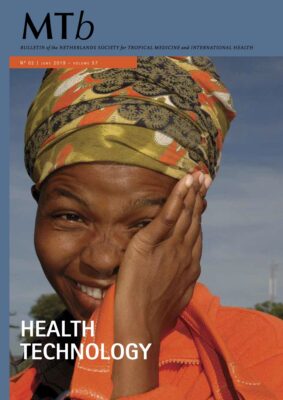
Health Technology
Editorial
In a letter to Dutch Parliament last April, the Dutch Minister of Health, Bruno Bruins, set out his vision on medical technology and gave an analysis of what MedTech has to offer and the challenges that it poses. With his focus on optimal use of innovations, the Minister explained how government tries to guide the development of new technologies and their integration in actual health practice. The range is diverse: from ICT solutions (eHealth) – such as tele-monitoring, wearables (e.g. blood pressure meters) and health apps (mHealth) – to robot surgery, 3D-printed orthopaedic prostheses, tissue engineering and much more. The Netherlands has a long history of providing imaging equipment (X-ray, ultrasound, MRI) to district hospitals in most of sub-Saharan Africa, combining development cooperation with the promotion of Dutch business interests long before the Ministry of Development Cooperation was rebranded Foreign Trade and Development Cooperation. It was not always a success formula as several evaluations concluded, pointing at faltering user support and deficient maintenance of the hardware involved, but it definitely stimulated our foreign export. Some technological innovations find their way to countries with weak health systems, including new forms of medication, medical devices, diagnostic tools for diagnosis at primary health care level or even self-diagnosis, and communication channels to support remote personalised care and training. The added value of new technologies is not always immediately clear, and sometimes there simply is not much added value. Time and again, it proves difficult to tailor technical solutions to local circumstances. For each MedTech innovation it is appropriate to ask which unmet need it really tries to address. Does it have any added value, in terms of health benefits, and for whom? Is there sufficient human capacity and are the infrastructural requirements in place? Is it financially affordable, for patients, hospitals and health systems as a whole? What about its cost-effectiveness, a parameter typically used by health economists? For them it is perhaps the main decisionmaking criterion but not necessarily for health practitioners, who are keen to do anything that serves their patients. What would the health budget impact be if new technologies – expensive as they sometimes are – were financed from public resources? Can we afford to include all promising new technologies and medicines in our health insurance benefits package? How would that affect our health insurance premiums? There are also ethical dilemmas. Do we want to continue treating debilitating or terminal conditions just because we can? Now that we can monitor so many of our body indices and life style features on a 24-hour basis, do we still have the liberty to decide not to know? Health technology assessment (HTA) is a field of expertise of growing importance. HTA science helps to gather evidence on the issues raised above, as the first article in this edition explains. Subsequent articles give insights in the work of health scientists and practitioners who develop MedTech solutions in the field: monitoring and improving adherence to TB treatment in the Philippines, Tanzania, Ukraine and in Paraguay, and ultrasound technology for pregnancies in Ethiopia. The implications of rapid diagnostic tests for the role of laboratories are the subject of another article. Judge for yourself whether MedTech offers solutions in resourceconstrained working environments. We welcome any reactions you may have! Lastly, we are happy to introduce our new column ‘News from the NVTG working parties’. The spotlight this time is on Ophthalmology, one of the smaller, less well-known groups. And guess what: it discusses the role of technology in eye care.
Leon Bijlmakers





















































